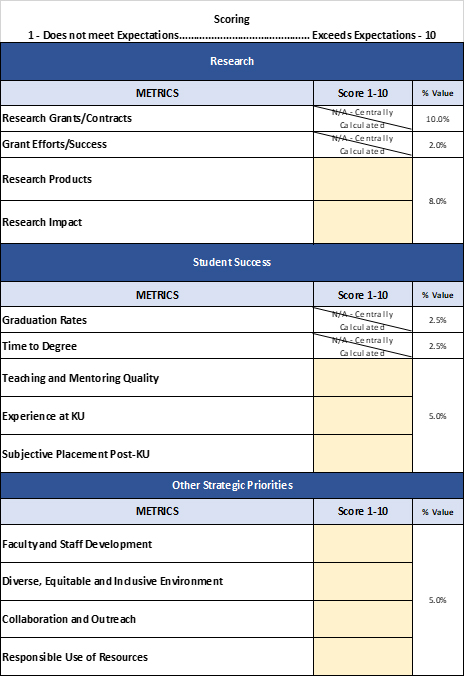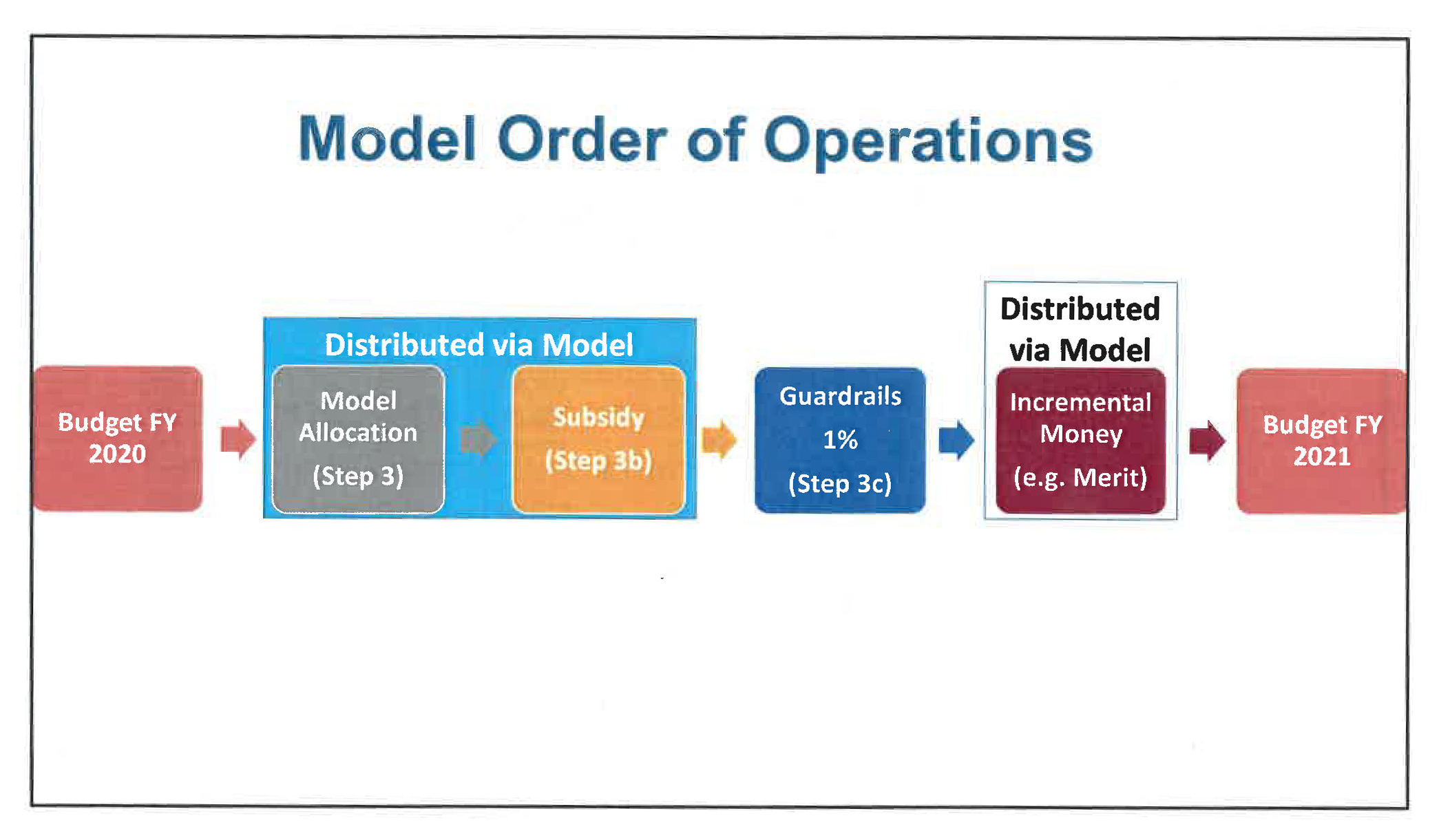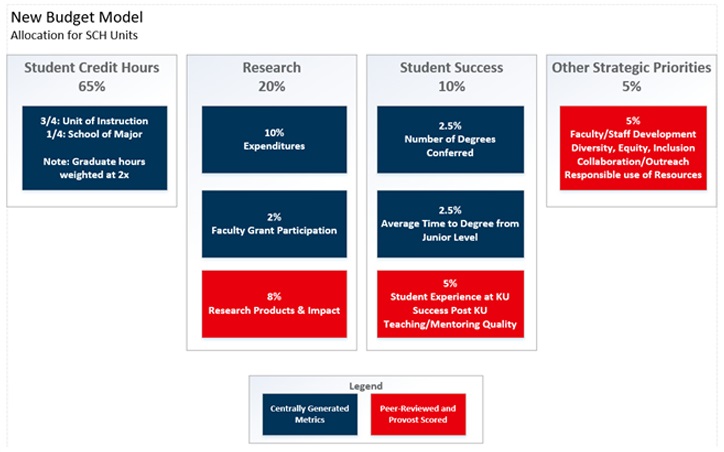Funding Process Academic Units
The new budget model is set up to encourage growth and activities that align with fundamental expectations of the institution such as sustained or growing enrollment, increases in scholarly works or research expenditures, student success such as degrees conferred, and more. The Budget Model Working Group identified and tested a variety of formulas that capture the essence of the higher education mission of the university and also respects the diversity of activities across disciplines.
Under KU's Priority Centered Management model, funding is allocated through a 3-step process:
- Step 1: Budget allocated to foundational priorities
- Step 2: Budget allocated to institutional strategic priorities
- Step 3: Budget allocated to academic units and support units. This step includes funds set aside to subsidize units and uses separate formulas for academic units and support units
Step 3
Every year, the academic units — the Schools and the College of Liberal Arts & Sciences — will be evaluated based on objective and subjective metrics in four categories. Each category will account for a percentage of a unit’s total allocation.
Several of these revenue allocation categories will have objective metrics and subjective valuations that determine allocation. Roughly 82% of the funding is related to centrally generated metrics and measures (65% to SCH and another 17% to centrally generated metrics related to research, student success, and other strategic priorities). Peer-reviewed and provost scored categories account for the remaining 18%. See the section on about evaluation/scoring for additional detail.
The formula recognizes that there is a cost for instructing students as well as a cost for guiding and mentoring students through a major. It also recognizes that graduate instruction carries additional expectations of faculty and staff.
Undergraduate Student Credit Hours
75% Unit of instruction
25% School of major
Graduate Student Credit Hours
Weighted at 2x
Here are two things to know about this portion of the formula:
- Objective metrics for purposes of budget allocation will be generated each year by Analytics & Institutional Research.
- In the event a student is pursuing dual degrees across multiple academic units, both units would get credit for that student as school of major.
This formula uses both objective and subjective information to determine allocation related to research and scholarship. It recognizes that some disciplines have access to limited grant funding, but may find strength through creative or other scholarly works. The formula also values reputational influence metrics, such as awards and recognition, invited presentations, and some professional service such as journal editing. Deans will work with staff at KU Office of Research, AIR and in the Center for Faculty Development and Mentoring to utilize a variety of tools and data sets that capture a robust picture of activity and impact within their unit.
Research Grant Expenditures - 10% (i.e. half of the 20% of the research variable)
- Centrally generated objective metrics
- Includes direct and indirect costs
- Doesn't favor federal vs non-federal funding
Faculty Grant Participation - 2%
- Centrally generated objective metrics
- Percent of faculty with an active grant either as PI or Co-PI
- Based on number of faculty in the unit; not number of attempts or grants
Products - 4%
- Unit-generated, subjective metrics (with support from AIR)
- Can include journal articles, books, chapters; creative, scholarly and legal works; invention disclosures and patents issued
Impact - 4%
- Unit-generated, subjective metrics (with support from AIR)
- Can include awards and recognition; invited presentations; citations and citation index; editorships; national or disciplinary ranking; societal and economic impact.
Just as important as recruiting students to KU is ensuring they are successful and timely in their academic journeys and that they make progress toward their career aspirations after graduation. The formula supports academic activities that develop resilient, agile life-long learners.
Centrally generated metrics - 5%
- Number of degrees conferred – 2.5%
- Average time-to-degree from junior level 2.5%
Unit-generated metrics - 5%
- Teaching and mentoring quality
- High-impact experiences/student experience at KU
- Success after graduation (hiring results/advanced degree programs)
Unit-supplied subjective metrics on four general categories of strategic priorities will be reviewed to determine an academic unit’s final portion of the allocation formula.
- Faculty & staff development
- Diverse, equitable and inclusive environment
- Collaboration and outreach
- Responsible use of resources
Deans will share information about how their programs have supported career development for faculty and staff; how their unit has worked to create a supportive environment for all members of their community; how the unit has worked across disciplines or across the region and state; and how they have been good stewards of the funds at their discretion.
While five percent may not seem significant in relation to the larger formula, the amount allocated based on each of these variables is sufficient to make an impact on the budget of each unit and ultimately across the university.
Provost and Peer-Reviewed Scoring
Every year leaders of academic units will work with AIR, the Office of Research, the Center for Faculty Development & Mentoring, and within their own programs to assemble information about their activities and successes – basically documenting progress toward their unit’s strategic plans.
In February, deans will deliver short presentations covering the subjective portions of the larger academic unit formula (portions of the research, student success and other strategic priorities categories, which account for 18% of the annual allocation). Currently, the duration of each presentation is based on the size of the unit.
- 30-40 minutes – The College of Liberal Arts & Sciences.
- 20-30 minutes – The schools of Business, Education, Engineering, and Pharmacy.
- 10-20 minutes – The schools of Architecture & Design, Journalism, Law, Music, and Social Welfare.
The presentations will be evaluated and scored by other senior leadership at the university and will be observed by governance leaders at KU. A score sheet will help guide reviewers in their evaluations. Results from the scoring will guide allocations on areas that make up to 18% of a unit’s annual budget allocation.
Current version of the score sheet:

Step 3a - Subsidy
All Responsibility Centered Management models and KU’s Priority Centered Management (PCM) Model include some relationship between revenue generated through tuition and the resources provided to a unit. However, if budgets were based purely on revenue generated, some units would not have a sufficient budget to operate. Subsidy is used to support these units and are based on a variety of factors including high-instructional and/or research costs as well as foundational importance within the university.
Subsidy is a budgetary pool of funds that allows rebalancing of revenue to guide the university’s direction. The allocation of the subsidy pool is guided by metrics as well as the discretion of the provost. Some academic units may require long-term subsidy, while others may require a short-term subsidy due to enrollment shifts or other market changes.
The subsidy will be based:
- 50% on a unit’s instructional costs, (which will also be compared to average instructional costs of peer institutions to ensure KU’s costs are in line with discipline and geographic norms).
- 50% through the provost’s discretion. This will be informed by metrics and the best interests of the institution.
The provost will set the total subsidy budget using the following guidelines:
- Support degree programs in strategic areas to ensure a portfolio of programs appropriate for a research university of KU’s stature.
- Recognize that there is a variance in the instructional cost of delivering programs by discipline. This variance must also consider efficiency levels relative to comparator data and the ability of a school to generate differential tuition.
- Reinforce the central role of research in KU’s mission, with emphasis on maintaining research capabilities in high-potential areas.
- Units cannot receive subsidy that increases their current budget beyond their prior year budget.
The subsidy pool of funds will initially be set at $20 million for FY20, roughly 10% of the overall academic unit allocation. The amount allocated to the subsidy pool will be reevaluated and determined each year by the provost in consultation with other senior leadership.
Step 3b - Guardrails
“Guardrails” are a strategy to reduce the impact of budget fluctuations due to model implementation.
Smoothing parameters have been set to help units prepare for changes in their year-to-year allocations. During the first few years of the budget model, gains or losses for each school or the College will be governed by the chart:
- FY20: Historical budget model
- FY21: +/- 1% (as compared to the prior year)
- FY22: +/- 2%
- FY23: +/- 2%
- FY24 & beyond: Continuation and setting of the smoothing guardrails will be re-evaluated every 3 years.
The extended time-frame of guardrail of use in the new budget model helps unit leaders ease into appropriate budgetary adjustments. Unit leaders can make more modest adjustments that either serve to limit distress or avoid wastefulness.
Special Notes About Guardrails and Subsidy
Guardrails
It must be stressed that guardrails are only in relation to the allocation model itself. If less money is put into the allocation due to campus-wide budget cuts, provost discretion, or other reasons, the units' overall budget change may be greater than that indicated by the guardrails.
Subsidy
The working group ran a variety of scenarios through the model and identified a possible, though unlikely, condition. It was noticed that certain situations (one example, an exceptional surge in research funding brought in by a single faculty member) could create a budget-related “windfall” for an academic unit. During the implementation years of the budget model, guardrails (Step 3b) will limit substantial swings in allocations, both up and down. During and after the implementation period, the model will be monitored for potential windfall anomalies. Absent of guardrails, the working group contemplated methods to constructively reduce the adverse effects of large unanticipated budget increases for isolated units. In such cases, one possibility might be using a levy that caps a unit’s budget allocation at 110% of the previous year’s budget. Excess funds would be diverted to the subsidy pool. The Budget Office and senior leadership will work closely with academic unit leaders when considering this possibility.
Order of Operations

Members of the working group made efforts to test the model under multiple scenarios as well as how different order of operations might affect the final allocation amount each unit receives.
- The process begins with a look at the current fiscal year distribution for each academic unit.
- The model formula (Step 3) is applied.
- Subsidy (Step 3a) is applied as necessary. The allocated funds for the coming fiscal year are compared with the allocation for the current year to determine subsidy levels.
- Guardrails (Step 3b) are applied, limited to 1% increase or decrease for the first year of the new budget model implementation.
- Incremental money, such as merit increases, are then distributed to the units.
Through these steps, academic units will know their allocations for the coming fiscal year months before it begins.
Contingency Funds
Despite all planning and review, unexpected events and influences can affect units in dramatic fashions. Contingency funds set aside in Step 1 – Foundational Priorities may be applied as a one-year relief effort in the event budget reduction is needed. Some situations where contingency may be called into play are an unexpected cut in state funding, or a rejected tuition proposal.
Contingency funds, part of centrally held reserves, will be capped at $5 million. Units needing contingency funds will be held harmless for 1 year and will be expected to develop a plan for budget reduction. Contingency funds must be repaid by the unit during the next fiscal year.
